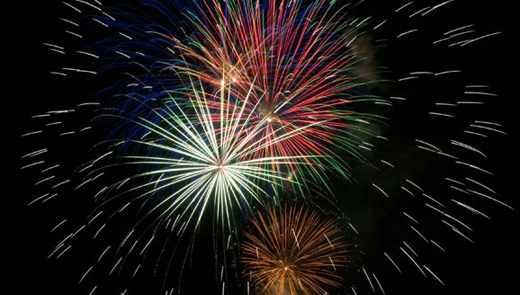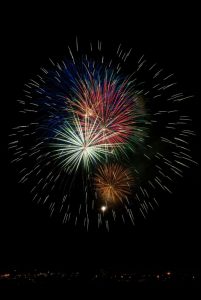Improving Your Photos of Fireworks
With the 4th of July quickly approaching, many of us will be staking out the best spots to watch the local fireworks displays. Photographing fireworks is actually pretty easy; with a little luck and good timing, it’s not too hard to just point and click to get a recognizable snapshot. If you want something a little more impressive, though, this simple technique will help you get more reliable results.
Before you get started, you’ll need:
- An SLR (or point and shoot that allows “bulb” exposures- consult your manual)
- A tripod
- a cable/remote release that allows for bulb exposures
Getting Set Up
To begin, mount your camera on the tripod and attach the cable release. Using a wide angle can be helpful, but as long as you can get the sky coverage that you want, lens choice is up to you.
Set your camera to manual exposure, or a “bulb” mode, if you camera has a special mode dial setting for it. With most cameras, you’ll dial your shutter speed past slower and slower, past 30 seconds, and the last option will be “bulb”. “Bulb” means that the shutter will stay open for as long as you hold the shutter button down, so you can shoot anywhere from a fraction of a second up to several hours. In practical terms, digital noise is a problem with exposures over a minute or two (depending on the camera), and battery life can be a limiting factor.
Set your aperture to something relatively small: around f/11, and your ISO to your lowest native setting (usually 100 or 200).
The idea is this: when the fireworks start, hold down the shutter button on your cable release (which holds your camera’s shutter open) when you hear the first set of explosions (which launch the fireworks into the sky). Keep the shutter held down until the bursts have faded, and then check your exposure on the back of your camera.
- If your screen (or histogram) shows that the fireworks are too bright (and not very colorful), reduce the aperture to f/16 or smaller.
- If the fireworks look ok, but the sky is too bright, then simply reduce the amount of time that you hold the shutter open.
This system is nice because usually (unless you’re taking photos against a bright, city-light polluted background) the bright flashes of the fireworks are the only light that significantly contributes to the exposure, the background being too dim at f/11 or f/16. This allows you to hold the shutter open for several bursts in the sky, and pick and choose how many you want to appear in any single exposure.

The duration of the exposure also captures the entire cascade of burst, so they look full and bright. With a little practice, you’ll get the feel for how many bursts you can include without the exposure getting too bright.
If you prefer a more structured approach, set your exposure to about 10 seconds at f/11 instead of using bulb. Again, if the fireworks are too bright, reduce the size of the aperture (larger aperture number), and if the background is too bright, reduce the duration of the exposure (5 seconds, perhaps). Since the fireworks are very bright and only last for a fraction of the exposure, think of them as you would a strobe/speedlight: their brightness is controlled with aperture, not shutter-speed.
Unfortunately, I’m away from my image library, so I apologize for recycling the images in this article. I’ll re-work it once I get a chance. If any of you try this tonight, Good Luck! Let us know how things work out for you!





